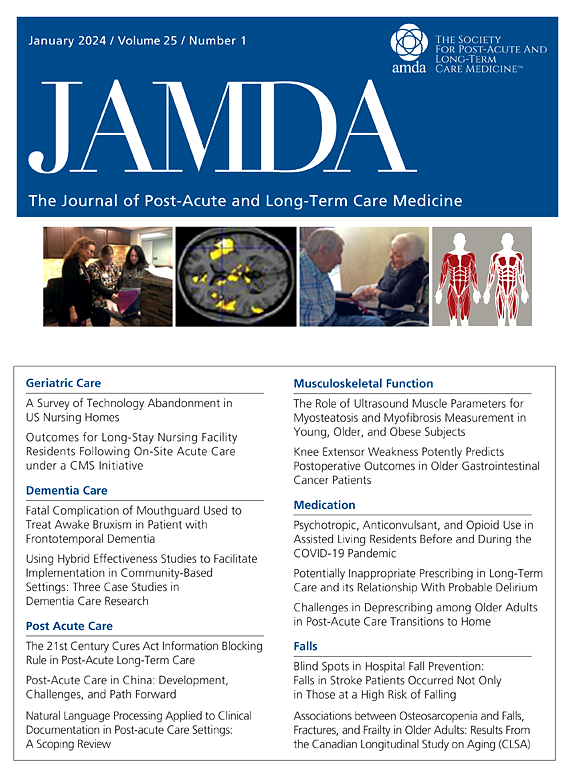哪种强化流感疫苗在长期护理居民中具有最大的免疫原性:佐剂制剂还是高剂量制剂?
IF 4.2
2区 医学
Q2 GERIATRICS & GERONTOLOGY
Journal of the American Medical Directors Association
Pub Date : 2025-05-30
DOI:10.1016/j.jamda.2025.105625
引用次数: 0
摘要
目的:本研究比较了老年人推荐的强化流感疫苗、佐剂流感疫苗(aTIV, FLUAD)和高剂量流感疫苗(HD- iiv3, FLUZONE HD),以确定它们是否符合老年长期护理机构(LTCF)居民的非劣效性标准。设计:在2018-2019和2019-2020两个流感季节(NCT03694808)进行的流感疫苗免疫原性随机、主动对照、非效性4期试验(NCT03694808)。环境和参与者:≥65岁的ltcf患者。方法:使用计算机生成的随机化方法,参与者以1:1的比例随机分配接受aTIV或HD-IIV3。只有实验室人员被蒙蔽。血凝抑制(HAI)和神经氨酸酶抑制(NI)测定在基线和接种疫苗后28天的抗体反应。主要终点比较第28天的几何平均滴度(GMTs)。次要结局包括血清转换率和NI滴度。结果:我们随机选择387名LTCF居民在2个流感季节接受aTIV (n = 194)或HD-IIV3 (n = 193)。我们观察到在疫苗接种后第28天,aTIV和HD-IIV3对A/H1N1和A/H3N2的HAI水平不低(GMT比,1.03;95% ci, 0.76-1.4;和GMT比值为1.04;95% CI分别为0.73-1.48),符合非劣效性标准,95% CI上界结论和意义:总体而言,抗血凝素和抗尿氨酶滴度显示出疫苗之间的相似性,并支持它们都属于疾病控制和预防中心优先推荐的针对65岁至65岁人群的强化流感疫苗类别。本文章由计算机程序翻译,如有差异,请以英文原文为准。
Which Enhanced Influenza Vaccine Has the Greatest Immunogenicity in Long-Term Care Residents: The Adjuvanted or the High-Dose Formulation?
Objectives
This study compares enhanced influenza vaccines recommended for older adults, adjuvanted flu vaccine (aTIV, FLUAD) vs high-dose flu vaccine (HD-IIV3, FLUZONE HD) to determine if they met noninferiority standards for older long-term care facility (LTCF) residents.
Design
A phase 4, randomized, active-controlled, noninferiority trial on influenza vaccine immunogenicity conducted over 2 influenza seasons (2018-2019 and 2019-2020) (NCT03694808).
Setting and Participants
Residents of LTCFs aged ≥65 years.
Methods
Participants were randomized 1:1 to receive either aTIV or HD-IIV3 using computer-generated randomization. Only laboratory personnel were blinded. Hemagglutination inhibition (HAI) and neuraminidase inhibition (NI) assays measured antibody responses at baseline and 28 days postvaccination. The primary outcome compared the geometric mean titers (GMTs) at day 28. Secondary outcomes included seroconversion rates and NI titers.
Results
We randomized 387 LTCF residents to receive either aTIV (n = 194) or HD-IIV3 (n = 193) over 2 flu seasons. We observed noninferior HAI levels at postvaccination day 28 to A/H1N1 and A/H3N2 for aTIV and HD-IIV3 (GMT ratio, 1.03; 95% CI, 0.76-1.4; and GMT ratio, 1.04; 95% CI, 0.73-1.48, respectively), meeting noninferiority criteria with 95% CI upper bounds <1.5. However, noninferiority criteria were not met for influenza B HAI levels (GMT ratio, 1.21; 95% CI, 0.91-1.61). Also, noninferiority criteria for HAI seroconversion were not met for any of the 3 strains. Applying the same noninferiority criteria to NI, both day 28 titer and seroconversion in aTIV were noninferior to HD-IIV3 for A/H1N1 and A/H3N2 strains.
Conclusions and Implications
Overall the anti-hemagglutinin and anti-neuraminidase titers demonstrate similarities between the vaccines and support them both being in the enhanced flu vaccine category preferentially recommended by the Centers for Disease Control and Prevention for people aged ≥65 years.
求助全文
通过发布文献求助,成功后即可免费获取论文全文。
去求助
来源期刊
CiteScore
11.10
自引率
6.60%
发文量
472
审稿时长
44 days
期刊介绍:
JAMDA, the official journal of AMDA - The Society for Post-Acute and Long-Term Care Medicine, is a leading peer-reviewed publication that offers practical information and research geared towards healthcare professionals in the post-acute and long-term care fields. It is also a valuable resource for policy-makers, organizational leaders, educators, and advocates.
The journal provides essential information for various healthcare professionals such as medical directors, attending physicians, nurses, consultant pharmacists, geriatric psychiatrists, nurse practitioners, physician assistants, physical and occupational therapists, social workers, and others involved in providing, overseeing, and promoting quality

 求助内容:
求助内容: 应助结果提醒方式:
应助结果提醒方式:


